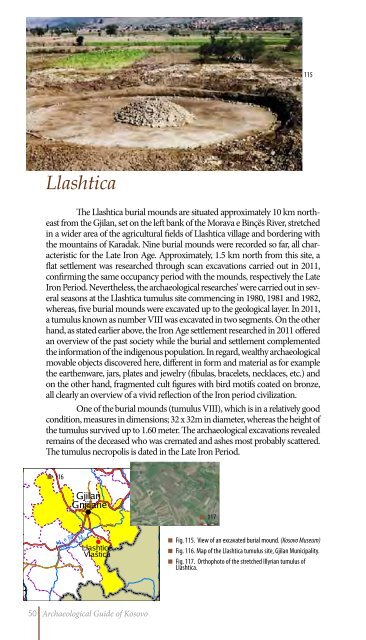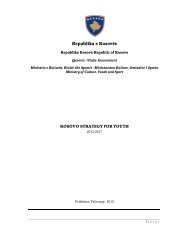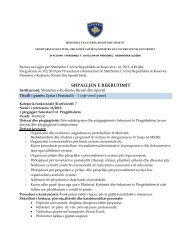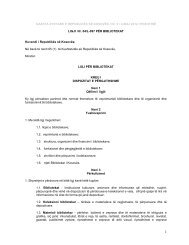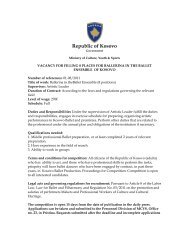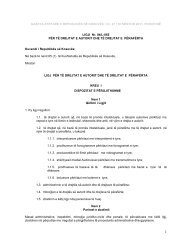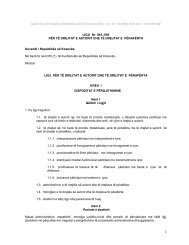Archaeological Guide of Kosovo
Archaeological Guide of Kosovo
Archaeological Guide of Kosovo
You also want an ePaper? Increase the reach of your titles
YUMPU automatically turns print PDFs into web optimized ePapers that Google loves.
115<br />
Llashtica<br />
The Llashtica burial mounds are situated approximately 10 km northeast<br />
from the Gjilan, set on the left bank <strong>of</strong> the Morava e Binçës River, stretched<br />
in a wider area <strong>of</strong> the agricultural fields <strong>of</strong> Llashtica village and bordering with<br />
the mountains <strong>of</strong> Karadak. Nine burial mounds were recorded so far, all characteristic<br />
for the Late Iron Age. Approximately, 1.5 km north from this site, a<br />
flat settlement was researched through scan excavations carried out in 2011,<br />
confirming the same occupancy period with the mounds, respectively the Late<br />
Iron Period. Nevertheless, the archaeological researches’ were carried out in several<br />
seasons at the Llashtica tumulus site commencing in 1980, 1981 and 1982,<br />
whereas, five burial mounds were excavated up to the geological layer. In 2011,<br />
a tumulus known as number VIII was excavated in two segments. On the other<br />
hand, as stated earlier above, the Iron Age settlement researched in 2011 <strong>of</strong>fered<br />
an overview <strong>of</strong> the past society while the burial and settlement complemented<br />
the information <strong>of</strong> the indigenous population. In regard, wealthy archaeological<br />
movable objects discovered here, different in form and material as for example<br />
the earthenware, jars, plates and jewelry (fibulas, bracelets, necklaces, etc.) and<br />
on the other hand, fragmented cult figures with bird motifs coated on bronze,<br />
all clearly an overview <strong>of</strong> a vivid reflection <strong>of</strong> the Iron period civilization.<br />
One <strong>of</strong> the burial mounds (tumulus VIII), which is in a relatively good<br />
condition, measures in dimensions; 32 x 32m in diameter, whereas the height <strong>of</strong><br />
the tumulus survived up to 1.60 meter. The archaeological excavations revealed<br />
remains <strong>of</strong> the deceased who was cremated and ashes most probably scattered.<br />
The tumulus necropolis is dated in the Late Iron Period.<br />
116<br />
117<br />
Fig. 115. View <strong>of</strong> an excavated burial mound. (<strong>Kosovo</strong> Museum)<br />
Fig. 116. Map <strong>of</strong> the Llashtica tumulus site, Gjilan Municipality.<br />
Fig. 117. Orthophoto <strong>of</strong> the stretched Illyrian tumulus <strong>of</strong><br />
Llashtica.<br />
50 <strong>Archaeological</strong> <strong>Guide</strong> <strong>of</strong> <strong>Kosovo</strong>


